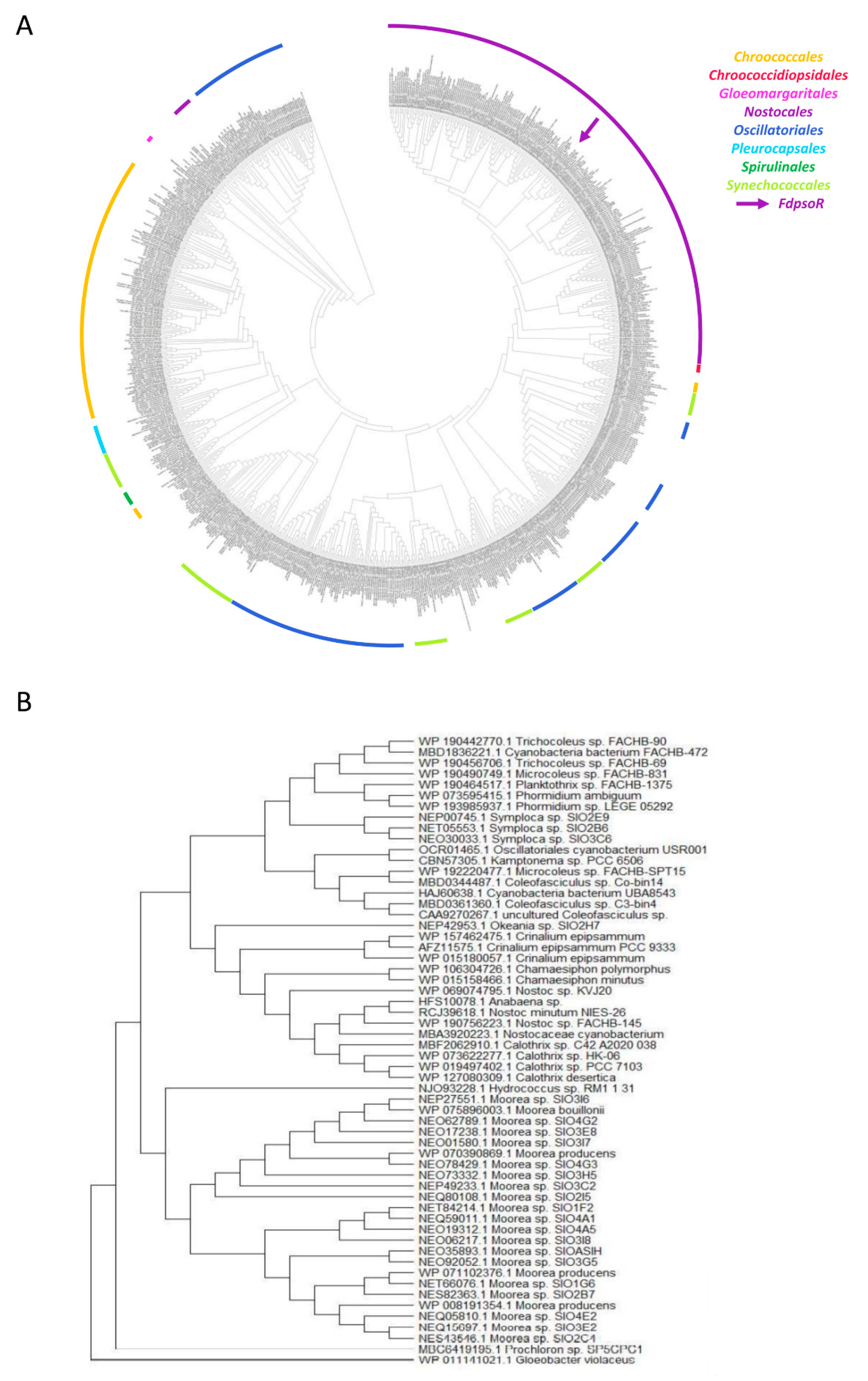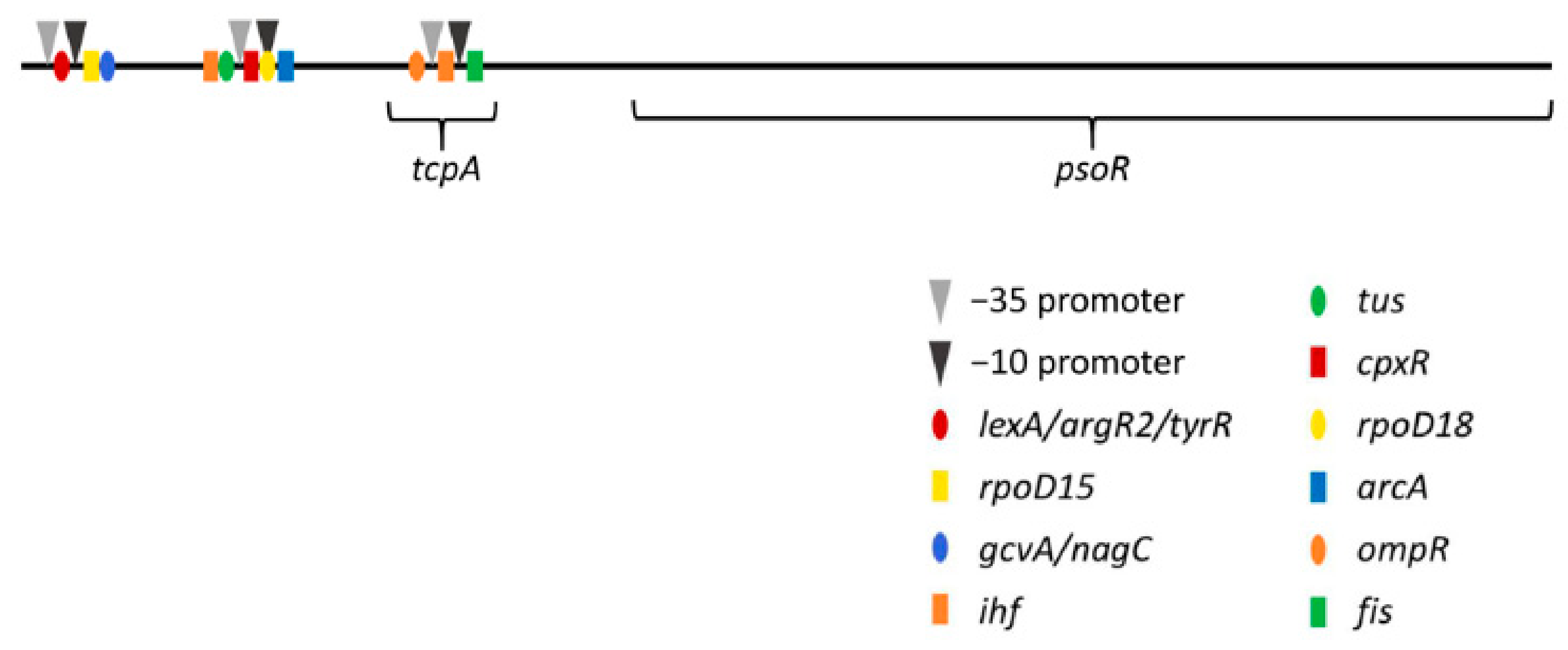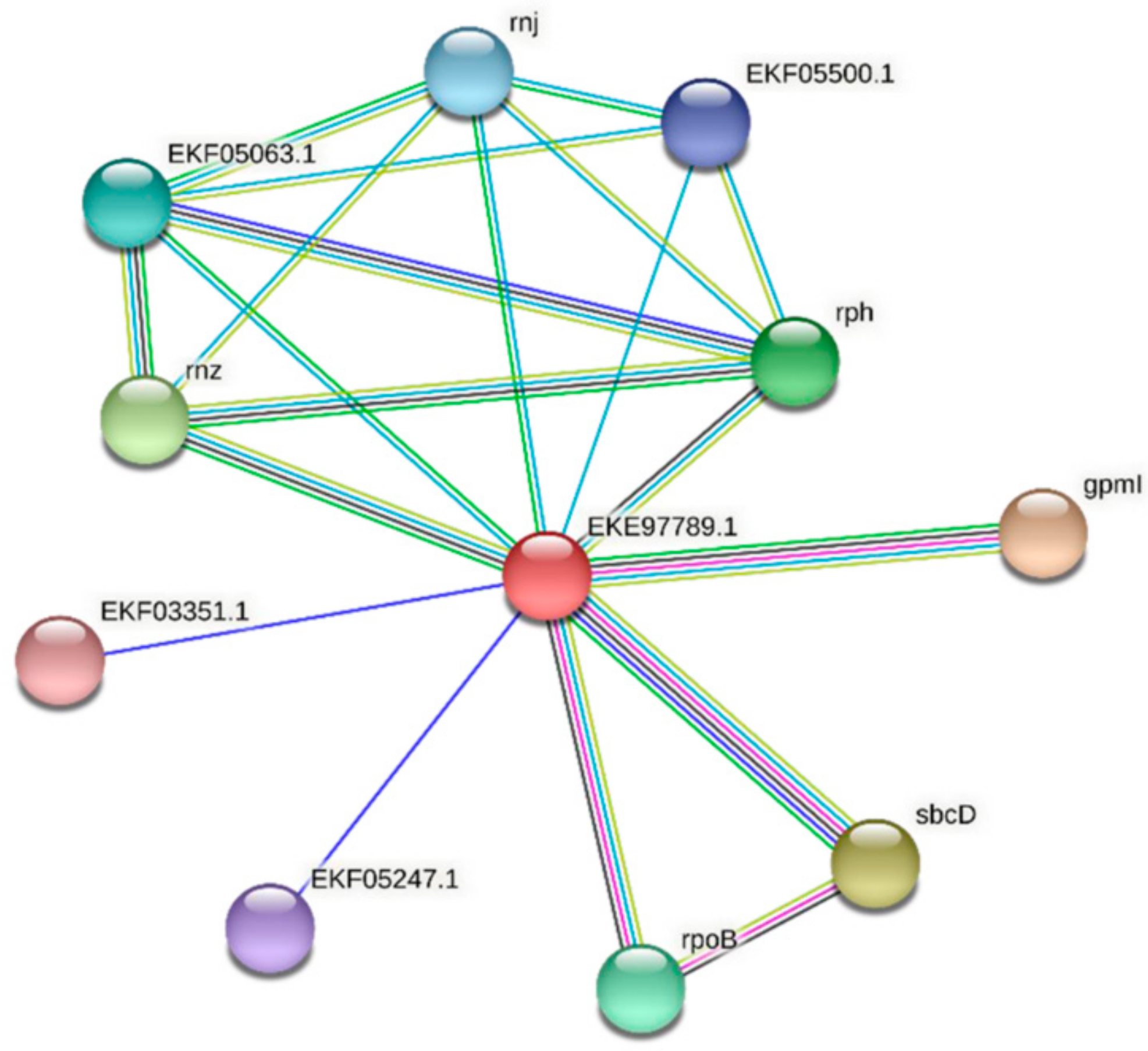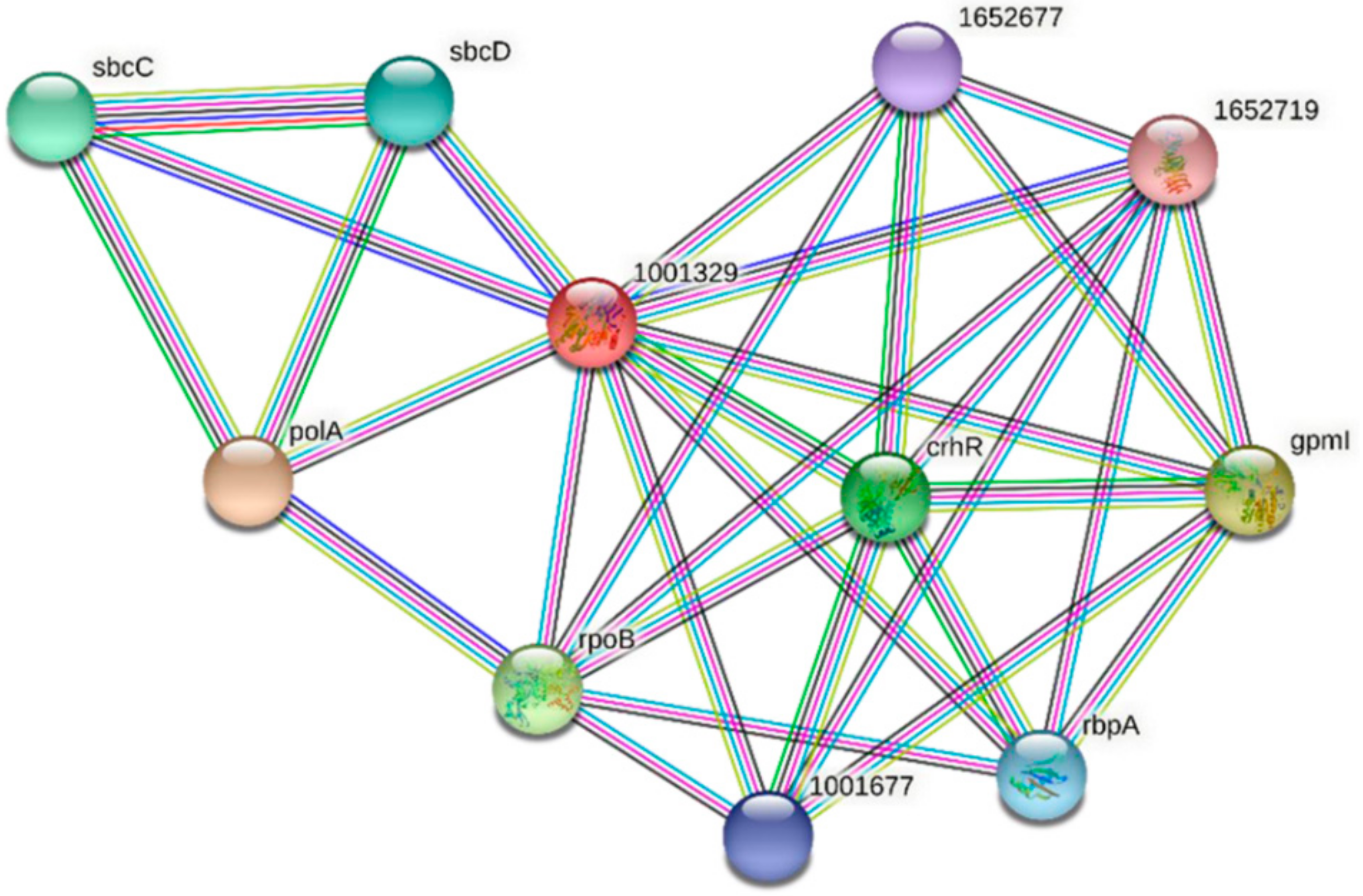1. Introduction
Cyanobacteria are oxygenic phototrophs that are responsible for 20–30% of global carbon fixation and the majority of global nitrogen fixation [
1,
2]. These prokaryotes serve as model organisms for studying photosynthesis and photoacclimation because of their fast growth and the tools available for the genetic manipulation of many species. In addition to research on the mechanisms governing their growth and fitness in natural contexts, there has been ongoing research into their use as a microbial chassis in the biotech industry for the production of biofuels, biopharmaceuticals, food supplements, bioremediation, and biofertilizers [
3,
4]. Due to the growing interest in this ancient phylogeny of bacteria, it is important to fully understand the genes and mechanisms that control their photosynthetic potential, productivity, and adaptive responses.
Cyanobacteria have evolved to survive in a wide range of ecological niches, including freshwater and marine environments, as well as in arid deserts, arctic tundra, and hot springs [
5,
6,
7]. The dynamic conditions in these environments present various challenges for cyanobacteria, including nutrient limitations and fluctuating light levels, which impact organismal growth and fitness. To deal with variable photoenvironments, cyanobacteria have evolved a mechanism called chromatic acclimation (CA), which allows them to perceive and respond to a given light condition and adjust their physiology and metabolism accordingly to maximize productivity while minimizing the photodamage caused by excess light absorption [
8,
9,
10].
A major cellular change that occurs during CA includes alterations to the pigment profile of phycobilisomes (PBS), which are accessory light-harvesting antennae that capture and transfer light energy to chlorophyll-containing photosystems for photosynthesis. PBSs are made up of phycobiliproteins that form a core with outward-radiating rods [
11,
12]. The PBS core is attached via a core-member linker to chlorophyll-containing reaction centers embedded in thylakoid membranes [
13]. In addition to altering the rod pigments during CA in response to changes in the prevalence of red light (RL) vs. green light (GL) and the light intensity, PBSs undergo restructuring and degradation under high-stress conditions, such as in high light and with nutrient limitations [
14,
15,
16,
17,
18,
19]. As PBSs are light-harvesting accessory complexes, their structure changes during CA and in response to stresses, which has implications for pigment coupling and energy transfer rates [
20,
21], and ultimately, the overall photosynthetic potential and efficiency.
Three main types of CA have been discussed in the literature for nearly 50 years. Distinct CA types are largely categorized by whether and how RL-absorbing phycocyanin (PC) and GL-absorbing phycoerythrin (PE) phycobiliproteins are synthesized and incorporated into the rods of PBSs in response to the availability of external light [
11,
22]. Type I CA occurs when cyanobacteria do not alter the levels of PC or PE under different light conditions. In cyanobacteria that exhibit type II CA, PC levels remain unchanged, whereas PE levels are tuned in response to light cues, where PE is induced under conditions rich in GL wavelengths. In cyanobacteria with type III CA, which is also known as complementary chromatic acclimation (CCA), PE accumulates under GL, whereas inducible PC (PCi) differentially accumulates in the outer portion of PBS rods under RL [
23]. Recently, additional forms of CA have been discovered in cyanobacteria that respond to other types of light, including type IV CA, in which organisms respond to blue and green wavelengths of light [
24] and far-red light photoacclimation (FaRLiP), which results in cyanobacterial tuning of PBSs in response to RL and far-red (FR) light [
25,
26].
CCA, which is the form of CA that has been studied the most extensively in freshwater filamentous cyanobacterium
Fremyella diplosiphon [
14], is largely under the control of the photoreceptor RcaE [
27]. RcaE works through two response regulators, RcaF and RcaC, to exert transcriptional regulation of the pigment content of PBSs in response to dynamic light signals [
28,
29,
30]. RcaC is a DNA-binding transcriptional regulator that directly controls the expression of phycobiliprotein-encoding genes [
31,
32,
33]. Under RL conditions, RcaC binds to and upregulates the
cpc2 operon, which codes PCi proteins and upregulates
pcyA, which in turn, codes an oxidoreductase that produces phycocyanobilin. The latter is the bilin that attaches to PC [
31,
34]. In RL, RcaC also represses the
cpe operon, which produces PE proteins, and the
pebAB operon, which encodes two oxidoreductases that produce phycoerythrobilin, which is the bilin that attaches to PE [
31,
33]. Under GL conditions, the repression of PE synthesis genes is relieved, resulting in PE accumulation [
11]. In addition to RcaE, PE levels are also regulated by the Cgi system, a GL-dependent regulatory system [
35].
An
F. diplosiphon mutant with a spontaneous transposon insertion within the phycobilisome abundance regulator gene,
psoR, displays disrupted pigmentation and growth [
36]. Here, we describe bioinformatic analyses that were conducted to explore the presence of PsoR across cyanobacteria, as well as an assessment of conserved residues and putative interacting partners, with the aim of understanding its potential function. Sequence and phylogenetic analyses determined that PsoR was widespread throughout the cyanobacterial phylum but absent both outside of cyanobacteria and in PBS containing red algae. The results of the analyses of conserved protein sequences and amino residues suggested that PsoR functions as a β-CASP domain-containing ribonuclease within the metallo-β-lactamase fold superfamily, which may have direct implications for regulating pigment synthesis in vivo. Additionally, putative PsoR-interacting proteins further supported a potential role for the protein in regulating PBS abundance in response to external light cues and/or stress.
4. Discussion
Considering the critical role of light energy in photosynthesis, mechanisms that allow photosynthetic organisms, such as cyanobacteria, to perceive and respond to fluctuating light environments are vital for organisms to survive and thrive. In cyanobacteria, CCA involves a network of photoreceptors, effectors, and gene operons to finetune pigmentation, cell morphology, filament morphology, and metabolisms in response primarily to RL and GL. The
psoR gene has been reported to encode a protein that negatively regulates PBS abundance [
36]. Although significant insights have been gained into the regulation of structural genes needed for PBS synthesis, particularly in response to light cues during CA, the regulation of PBS abundance has not been extensively examined in cyanobacteria at the mechanistic level. To understand the roles of PsoR in CCA and cyanobacteria, we assessed its potential structure and function and searched for homologs across the cyanobacterial kingdom to determine when this gene may have arisen in these organisms.
The putative function of PsoR was investigated using the Phyre2 program. The protein encoded by
psoR contains a predicted β-CASP domain, including a collection of conserved motifs/residues involved in the processing of DNA and RNA substrates. The β-CASP family of enzymes belongs to the metallo-β-lactamase superfamily, which includes proteins that process a wide variety of substrates in organisms. β-CASP proteins are found in all three domains of life, and they play a predominant role in pre-mRNA processing, although some β-CASP enzymes are involved in DNA repair [
44,
45,
60]. The conserved motifs of PsoR are involved in metal binding, typically zinc ions, and in stabilizing nucleic acid substrates for cleavage. Due to its β-CASP domain and as all prokaryotic β-CASP enzymes identified thus far have been ribonucleases, the role of PsoR in cyanobacteria may be the regulation of mRNA, and it may specifically regulate genes involved in PBS abundance. Other β-CASP proteins tend to function as dimers or within larger protein complexes, usually binding through the C-terminal region of the β-CASP domain or a separate C-terminal region [
45,
47,
48,
49]. Given the presence of 123 residue C-terminal regions in
FdPsoR, PsoR may also function as a dimer in vivo or may work through interactions with other proteins.
Homologs of PsoR from
F. diplosiphon were found across the Cyanobacteria phylum, and only
Gloeobacter lacked a homolog.
Gloeobacter are an ancient clade of cyanobacteria that lack thylakoid membranes and have atypical PBSs. Instead of rods grouped around a hemisicoidal core,
Gloeobacter PBSs are grouped in bundles of parallel rod-shaped structures attached to cytoplasmic membranes [
52,
53].
Gloeobacter also lacks the genes
psbY,
psbZ, and
psb27, which encode subunits of photosystem II [
53,
61]. Homologs of PsoR were not found in red algae or other organisms, which suggests that PsoR homologs arose sometime after branching off from
Gloeobacter, perhaps around the time that more complex PBSs evolved. Although red algae have PBSs similar to cyanobacteria, the lack of PsoR homologs may indicate a different enzyme or system for regulating PBS abundance in these distinct organisms.
The range of sizes found among PsoR homologs is notable. As the smallest homologs did not form a distinct branch but were found to be intermingled with homologs in sizes closer to
FdPsoR, perhaps these shorter homologs are truncated forms of PsoR (
Figure 4A). Whether they retain the functionality of PsoR needs to be explored experimentally. The 57 homologs that formed their own branch closest to the
Gloeobacter outgroup contained the longest homologs found in our analysis, at as much as 918 bp (
Figure 4B). Predominantly of the
Oscillatoriales order, they could be extended forms of PsoR.
Three predicted promoter start sites and multiple transcription factor binding sites preceded the
psoR gene; yet, one of the two regions also upstream of the neighboring
tcpA gene may be a more likely start site of transcription (
Figure 5). Previous work established that TcpA, or tetracontapeptide A, is a 40-amino-acid peptide encoded by a gene that appears to be co-transcribed with
psoR and may also play a role in PBS abundance regulation [
36]. As
tcpA was reported to be found upstream of
psoR in every cyanobacterial genome searched by Cobley et al. [
36], the presence of these two promoter regions provides further evidence that the two genes are co-transcribed in cyanobacteria where they are both found, and they may even work together in some way to regulate PBS abundance in these bacteria.
The predicted protein–protein interactions indicated interactions with protein partners involved in gene and metabolism regulation. Since FdPsoR is a putative β-CASP nuclease, it is possible that FdPsoR interacts with other proteins involved in regulating CCA and metabolism in response to environmental stimuli. Of note, a PC-associated protein was among the proteins predicted to interact with FdPsoR.
Light fluctuations in terrestrial and aquatic environments can occur frequently, in which the light quality and quantity are altered by factors such as cloud coverage and shading by other objects and organisms. The ability to perceive and respond to changing light conditions is important for cyanobacteria to maximize productivity and minimize damage caused by excess light in these dynamic conditions. Due to the important role PBSs play in CA and photosynthesis, understanding how PBSs undergo remodeling or how their abundance is tuned to external cues could extend our understanding of how cyanobacteria survive and thrive in fluctuating light environments. Although significant insights into the light quality-dependent regulation of the pigment content have been obtained during 50 years of research on CCA, many aspects of PBS regulation remain to be elucidated. Here, PsoR has been reported to be widespread across cyanobacteria, where it is likely to play a critical role in cellular PBS regulation. Understanding how PsoR functions as a β-CASP protein and its role in CCA and cyanobacteria can help lead to a better understanding of how photosynthetic organisms fine-tune their photosynthetic machinery in response to changes in their light environment. This knowledge may contribute to improvements in using cyanobacteria for industrial and pharmaceutical purposes.














